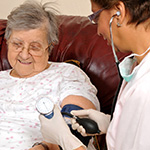Strategies for Caring for Holocaust Survivors
Identifying a Holocaust Survivor
Asking simple questions can help identify a Holocaust Survivor without directly asking. Clues include place of birth, date of birth, date of immigration to the United States, religion and languages spoken. Indications that a person is a Holocaust Survivor include heavily accented English, European languages spoken, lack of family members of same generational age and a number tattoo on the arm.
Gather crucial information
It is often difficult to obtain information from Holocaust Survivors about their past. They may not wish to revisit and disclose details about their past experiences. Once a patient is identified as a Holocaust Survivor, it is imperative that health care providers explain how the patient's personal information will be used.
Be sensitive to the fact that during the war, doctors and nurses conducted human medical experiments and meted out inhumane treatments to the Jews. If you are a health care provider, you must be cognizant of the potential effects of certain behaviors and treatments.
Effective ways to communication with Holocaust Survivors include:
- Empathetic statements—Let patients feel they are understood, emotionally supported and safe
- Acknowledgment—Assure patients that they are being heard and confirm that their message is of value and being taken seriously
- Open-ended questions—Invite and allow patients to share information rather than replying with 'yes' or 'no' answers, as simple responses are devoid of detail and
valuable information, which may prevent a full understanding of patients' situations - Reflective statements—Show patients your level of understanding
- Paraphrasing—Allow listeners (clinicians) and speakers (patients) to verify
information discussed to clear up potential misunderstandings - Gentle probing—Suggest further discussion to gather additional essential information
- Tone of voice—Speak calmly and with kindness, because how you communicate is often more powerful than what you say
Active listening approaches include:
- Attention to total meaning—Emotional content is especially important; at times it may offer more insight than verbal responses
- Noted cues—Observe nonverbal behavior to gain the 'total picture'
- Varied responses—Verbal and body language may best emphasize engagement, ranging from paraphrasing and silence to gestures
Being honest—Acknowledge when clarification or re-explanation is needed - Vocal empathy—Avoid phrases such as 'I know how you feel.' Although often well-intentioned, such statements are often perceived as patronizing
Download our free Guidebook: Caring for Holocaust Survivors with Sensitivity at the End of Life

This helpful guidebook provides a deeper understanding of end-of-life issues that may manifest in the Holocaust Survivor at the end of life.





